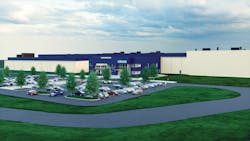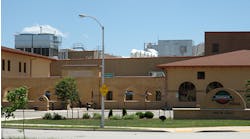After a year fraught with supply chain issues, labor shortages and rising costs, food & beverage processors appear poised to open their wallets for capital spending projects in 2023 at levels not seen in years.
33 of the largest publicly traded food & beverage companies highlighted in our 2023 Capital Spending Report plan to spend 21.4% more on capital expenditures this year than they actually spent in 2022. That’s the highest increase we've ever seen in these annual Capital Spending Outlooks, and we’ve been doing them since 2006.
Altogether, we’ve identified more than $23 billion in capital spending budgeted for this year. From all indications, food & beverage is ready to spend its way around the challenges that thwarted growth for some companies in 2022.
A year ago, processors continued to struggle (as they still do today) with the extreme labor shortages that hampered plant staffing and production. As a result, most companies’ capital spending plans for 2022 targeted automation, robotics and minimizing the number of workers needed to produce food safely and efficiently. New plants were designed for optimum “hands-free” flow, taking the human element out of the equation.
Comparing the 2022 budgets of the companies with their actual capital spending, the industry saw highly variable results on meeting those capital expenditures forecasts. As a group, those companies poured slightly more money than was budgeted into capital expenditures (0.73% higher than budget) in 2022, but the fluctuations from company to company were significant.
Campbell Soup, TreeHouse Foods, Maple Leaf Foods and others spent more than 25% below their budgets in 2022, for example, while J&J Snack Foods, Hostess Brands and Utz Brands overshot their capex allocations (and, for that matter, their 2021 actual capital spending as well) by significant amounts.
Yet, of the top 10 U.S.-based companies on the list, only PepsiCo and Pilgrim’s Pride invested more than budgeted in 2022. The story behind the slide in capital spending for 2022 follows familiar tropes.
The labor shortage, first of all, hindered some capital projects, explains Nathan Arnold, director of client development, food and beverage, for Hixson Architecture, Engineering & Process.
“Some clients spent less in 2022 because they couldn’t complete projects without the workforce they needed to execute them, so labor has affected construction and consulting,” he says. “We’re seeing a lot of opportunities in capital spending, but we can’t take them all on because there aren’t enough people to run the projects — and that has stressed out the system.”
“It’s fair to say that supply-chain constraints and raw-material cost inflation held back capital expenditures for some of the companies in the beverage universe over the past couple of years,” she explains. “However, for 2023, this global supply-chain issue seems to be largely in the rear-view mirror for most of those companies, and they don’t see that as a as a headwind going forward.”
Overall, Arnold says, there doesn’t appear to be a pullback on capital spending projects throughout the food industry, despite the challenges mentioned above.
“Clients whose products are still in demand, whose growth is steady and who had a long-term growth plan are still building,” he says. “There are a lot of new plants being built and capital being spent; the market is not really in the way because demand and growth are steady for those clients.”
Picking up steam
Since the pandemic, the top publicly traded companies have forecasted capital expenditures with growing enthusiasm every year: From 13% higher budget in 2021 over 2020 actual spend, to a roaring 21.4% increase expected in fiscal 2023 over 2022 actuals. Su sees the same commitment from companies in her coverage sphere.
“There is no reason for me to expect maintenance or growth capex change for the companies I cover, which is why I see 2023 being forecast similar [to past years],” she says. “That said, they are still exposed to macroeconomic volatilities, and I wouldn't be surprised if some companies reassess projects as interest rates go up.”
Arnold agrees that rising interest rates will come into play, and capital spending budgets more reliant on leveraging financing to pay for the projects could see a decrease. But that won’t affect everyone, he says.
Rising food prices for consumers also can temper any capital spending projects, though Su says processors haven’t needed to adjust to that yet.
“Companies are acknowledging the fact that inflation indeed has had a major impact on the personal finances of consumers, so they're watching that very closely,” she adds. “However, they haven’t seen a big change in the demand forecasting for their company yet.”
Another consumer-centric area Su believes could have an impact on future planning for processors is the rise and continued growth around health and wellness products.
“Health and wellness is a very meaningful driver for food and beverage consumers these days, one that has already started and could be a multi-year trend going forward,” she says. “Companies are talking about how to expand their innovation pipeline to include more low-calorie, low-sugar, low-fat, etc., but still retain the taste profile of the products.”
As product lines evolve to meet those needs and demand grows to match, processors will need to ramp up operations, add or renovate lines and build facilities to keep in lockstep. Portion control and new packaging opportunities are driving innovation for processors, Su adds.
From a facilities perspective, cost remains king, even for processors that have weathered some of the economic turbulence thus far, Arnold says. Since projects themselves may come in above original projections, processors are trying to keep costs under control wherever possible.
“One goal many clients have been looking at is ways to reduce their operations costs, and they have been willing to spend capital to cut operational costs long-term,” he says. “They want projects that assess HVAC, electrical, water usage and energy recovery systems — ones that give them a direct return on those operational costs.”
Those types of sustainability-driven projects have gained visibility in the era of corporate social responsibility reporting, Su says. Many of these investments, however, are part of multi-phase projects that can take years for the companies to achieve the goals they’ve set.
“Sustainability initiatives are certainly a meaningful trend, and many companies have targets set for carbon emissions, PET bottling and initiatives like that,” she says. “Those companies have been investing capital to ensure that they hit those targets.”




